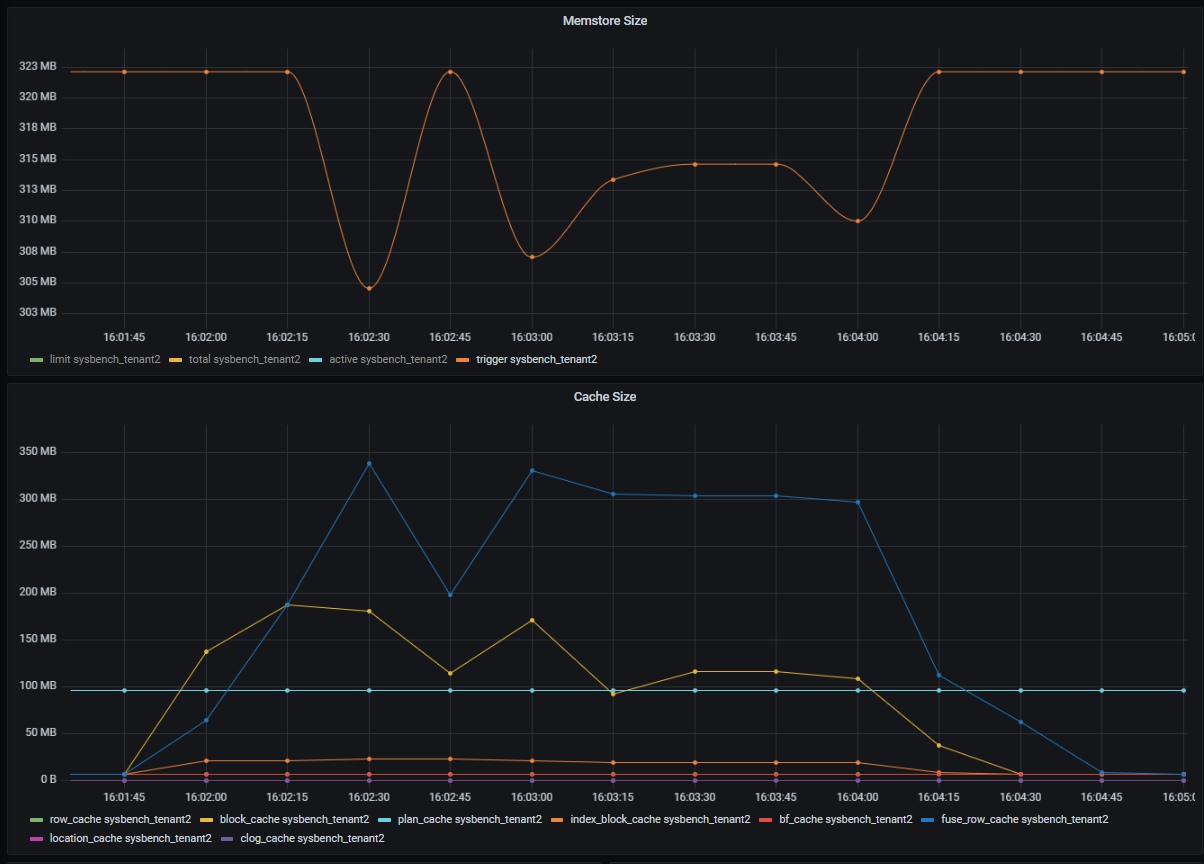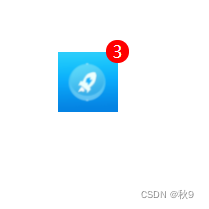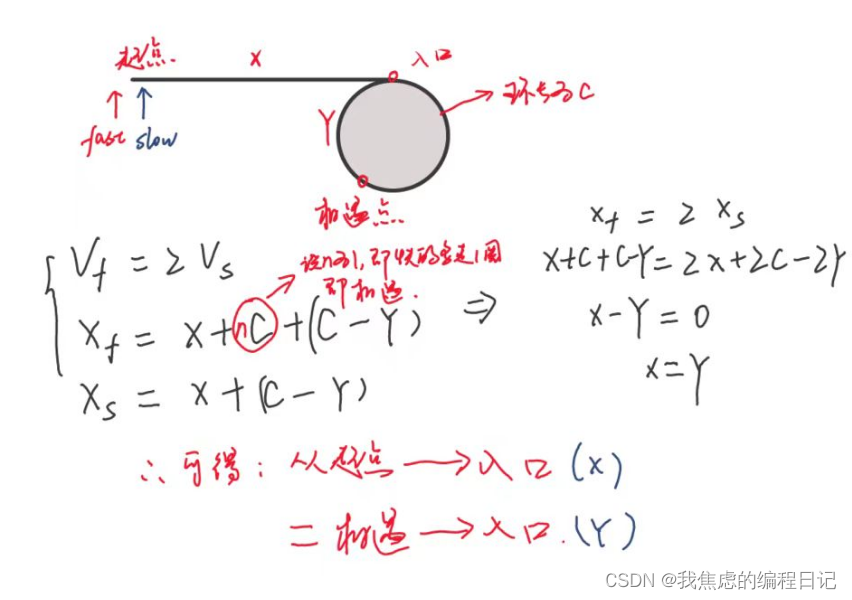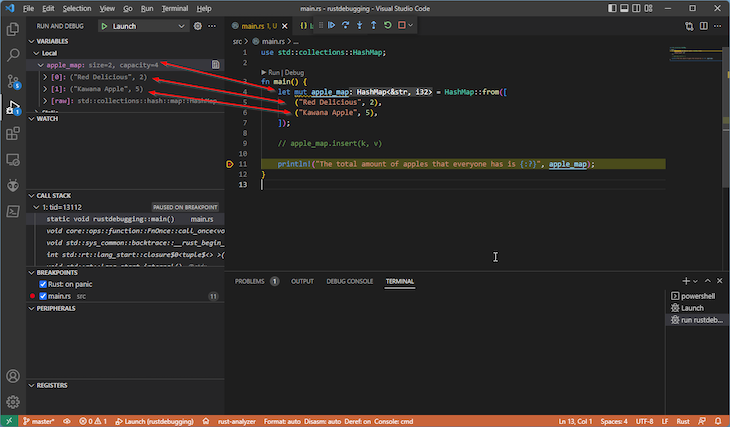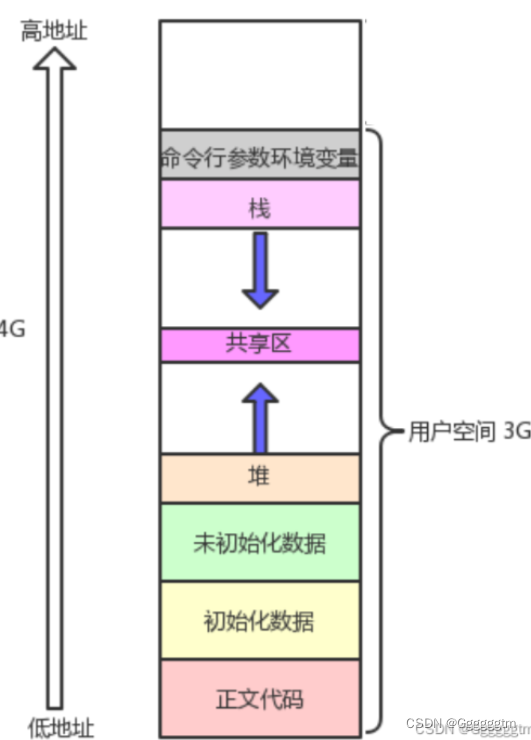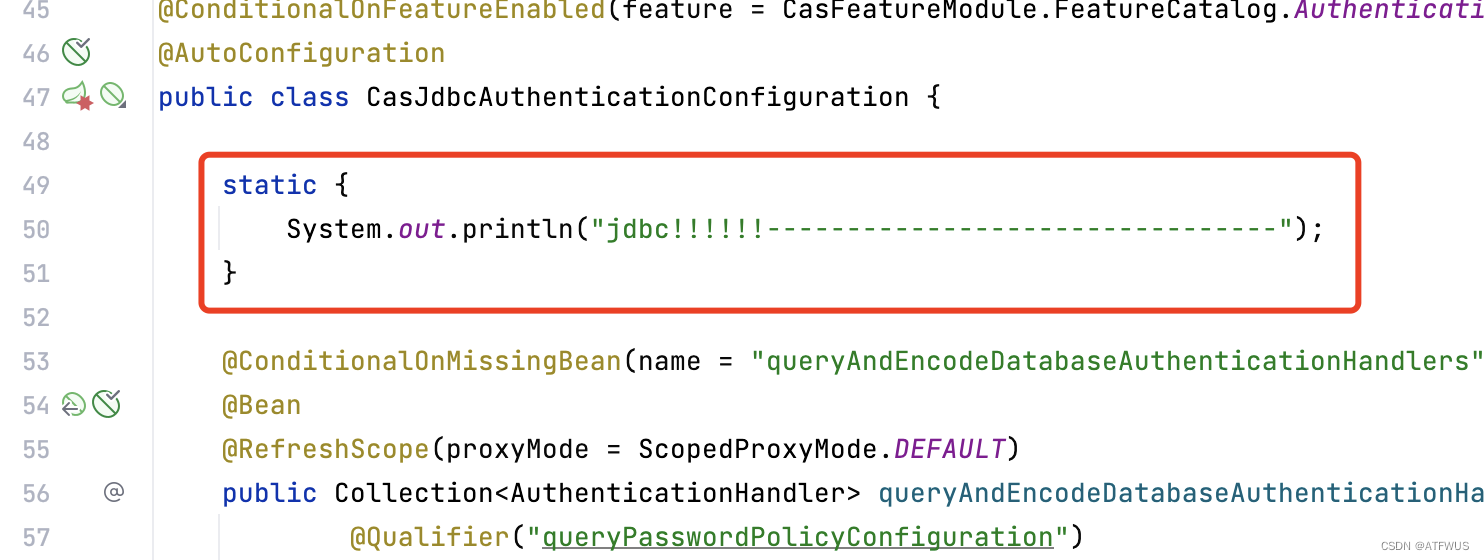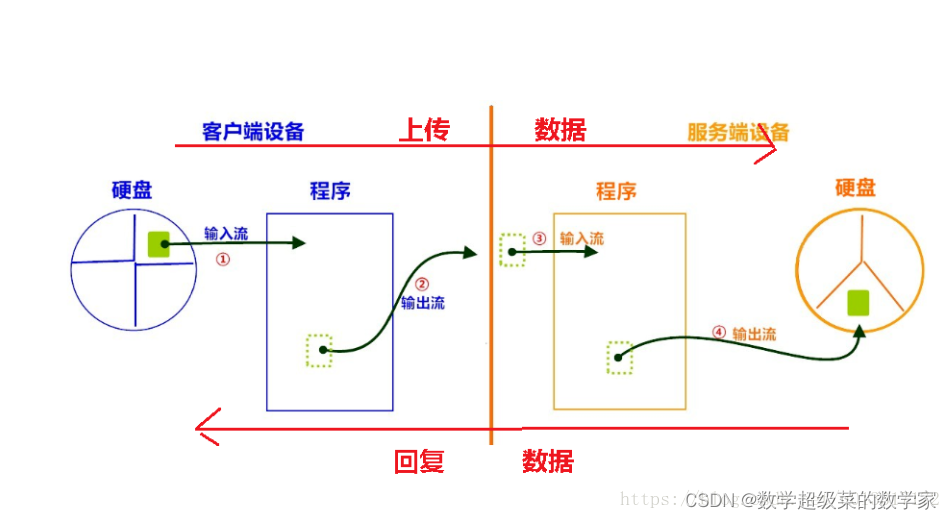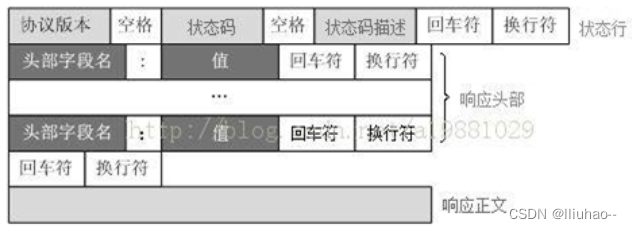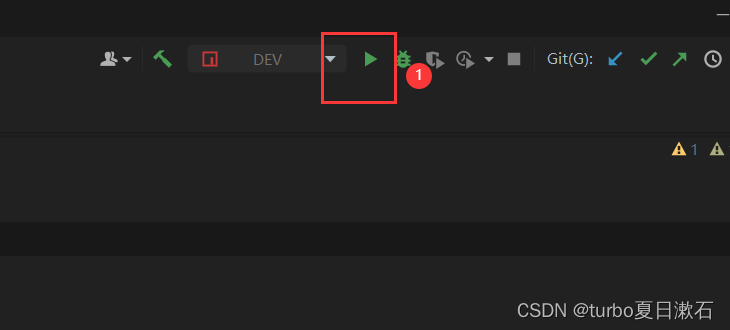在微服务应用中,考虑到技术栈的组合,团队人员的开发水平,以及易维护性等因素,一个比较通用的做法是,利用 AOP 技术 + 自定义注解实现 对特定的方法或接口进行限流。
下面基于这个思路来分别介绍下几种常用的限流方案的实现:
- 基于 guava 限流实现(单机版)
- 基于 sentinel 限流实现(分布式版)
- 基于 redis+lua 限流实现(分布式版)
- 网关限流(分布式版)
- 自定义 starter 限流实现
1. 基于 guava 限流实现(单机版)
guava 为谷歌开源的一个比较实用的组件,利用这个组件可以帮助开发人员完成常规的限流操作,接下来看具体的实现步骤
1、引入依赖:
<dependency>
<groupId>com.google.guava</groupId>
<artifactId>guava</artifactId>
<version>30.1-jre</version>
</dependency>
2、自定义限流注解
自定义一个限流用的注解,后面在需要限流的方法或接口上面只需添加该注解即可
@Documented
@Target(value = ElementType.METHOD)
@Retention(value = RetentionPolicy.RUNTIME)
public @interface GuavaLimitRateAnnotation {
// 限制类型
String limitType();
// 每秒 5 个请求
double limitCount() default 5d;
}
3、限流 AOP 类
通过AOP前置通知的方式拦截添加了上述自定义限流注解的方法,解析注解中的属性值,并以该属性值作为 guava 提供的限流参数,该类为整个实现的核心所在
@Aspect
@Component
public class GuavaLimitRateAspect {
private static Logger logger = LoggerFactory.getLogger(GuavaLimitRateAspect.class);
@Before("execution(@GuavaLimitRateAnnotation * *(..))")
public void limit(JoinPoint joinPoint) {
// 1.获取当前方法
Method currentMethod = getCurrentMethod(joinPoint);
if (Objects.isNull(currentMethod)) {
return;
}
// 2.从方法注解定义上获取限流的类型
String limitType = currentMethod.getAnnotation(GuavaLimitRateAnnotation.class).limitType();
double limitCount = currentMethod.getAnnotation(GuavaLimitRateAnnotation.class).limitCount();
// 3.使用guava的令牌桶算法获取一个令牌,获取不到先等待
RateLimiter rateLimiter = RateLimitHelper.getRateLimiter(limitType, limitCount);
boolean b = rateLimiter.tryAcquire();
if (b) {
System.out.println("获取到令牌");
} else {
HttpServletResponse resp = ((ServletRequestAttributes) RequestContextHolder.getRequestAttributes()).getResponse();
JSONObject jsonObject = new JSONObject();
jsonObject.put("success",false);
jsonObject.put("msg","限流中");
try {
output(resp, jsonObject.toJSONString());
} catch (Exception e) {
logger.error("error,e:{}", e);
}
}
}
public void output(HttpServletResponse response, String msg) throws IOException {
response.setContentType("application/json;charset=UTF-8");
ServletOutputStream outputStream = null;
try {
outputStream = response.getOutputStream();
outputStream.write(msg.getBytes("UTF-8"));
} catch (IOException e) {
e.printStackTrace();
} finally {
assert outputStream != null;
outputStream.flush();
outputStream.close();
}
}
private Method getCurrentMethod(JoinPoint joinPoint) {
Method[] methods = joinPoint.getTarget().getClass().getMethods();
Method target = null;
for (Method method : methods) {
if (method.getName().equals(joinPoint.getSignature().getName())) {
target = method;
break;
}
}
return target;
}
}
其中限流的核心 API 即为 RateLimiter 这个对象,涉及到的 RateLimitHelper 类如下:
public class RateLimitHelper {
private RateLimitHelper(){}
private static Map<String, RateLimiter> rateMap = new HashMap<>();
public static RateLimiter getRateLimiter(String limitType, double limitCount ){
RateLimiter rateLimiter = rateMap.get(limitType);
if(rateLimiter == null){
rateLimiter = RateLimiter.create(limitCount);
rateMap.put(limitType,rateLimiter);
}
return rateLimiter;
}
}
4、测试
@RestController
@RequestMapping("/limit")
public class LimitController {
@GetMapping("/limitByGuava")
@GuavaLimitRateAnnotation(limitType = "测试限流", limitCount = 1)
public String limitByGuava() {
return "limitByGuava";
}
}
在接口中为了模拟出效果,我们将参数设置的非常小,即QPS为1,可以预想当每秒请求超过1时将会出现被限流的提示,启动工程并验证接口,每秒1次的请求,可以正常得到结果,效果如下:

快速刷接口,将会看到下面的效果:

2. 基于 sentinel 限流实现(分布式版)
sentinel 通常是需要结合 springcloud-alibaba 框架一起实用的,而且与框架集成之后,可以配合控制台一起使用达到更好的效果,实际上,sentinel 官方也提供了相对原生的 SDK 可供使用,接下来就以这种方式进行整合
1、引入依赖
<dependency>
<groupId>com.alibaba.csp</groupId>
<artifactId>sentinel-core</artifactId>
<version>1.8.0</version>
</dependency>
2、自定义限流注解
@Documented
@Target(value = ElementType.METHOD)
@Retention(value = RetentionPolicy.RUNTIME)
public @interface SentinelLimitRateAnnotation {
// 限制类型
String resourceName();
// 每秒 5 个
int limitCount() default 5;
}
3、自定义AOP类实现限流
该类的实现思路与上述使用guava类似,不同的是,这里使用的是sentinel原生的限流相关的API,对此不够属性的可以查阅官方的文档进行学习,这里就不展开来说了
@Aspect
@Component
public class SentinelLimitRateAspect {
@Pointcut(value = "@annotation(com.hcr.sbes.limit.sentinel.SentinelLimitRateAnnotation)")
public void rateLimit() {
}
@Around("rateLimit()")
public Object around(ProceedingJoinPoint joinPoint) {
// 1.获取当前方法
Method currentMethod = getCurrentMethod(joinPoint);
if (Objects.isNull(currentMethod)) {
return null;
}
// 2.从方法注解定义上获取限流的类型
String resourceName = currentMethod.getAnnotation(SentinelLimitRateAnnotation.class).resourceName();
if(StringUtils.isEmpty(resourceName)){
throw new RuntimeException("资源名称为空");
}
int limitCount = currentMethod.getAnnotation(SentinelLimitRateAnnotation.class).limitCount();
// 3.初始化规则
initFlowRule(resourceName,limitCount);
Entry entry = null;
Object result = null;
try {
entry = SphU.entry(resourceName);
try {
result = joinPoint.proceed();
} catch (Throwable throwable) {
throwable.printStackTrace();
}
} catch (BlockException ex) {
// 资源访问阻止,被限流或被降级,在此处进行相应的处理操作
System.out.println("blocked");
return "被限流了";
} catch (Exception e) {
Tracer.traceEntry(e, entry);
} finally {
if (entry != null) {
entry.exit();
}
}
return result;
}
private static void initFlowRule(String resourceName,int limitCount) {
List<FlowRule> rules = new ArrayList<>();
FlowRule rule = new FlowRule();
//设置受保护的资源
rule.setResource(resourceName);
//设置流控规则 QPS
rule.setGrade(RuleConstant.FLOW_GRADE_QPS);
//设置受保护的资源阈值
rule.setCount(limitCount);
rules.add(rule);
//加载配置好的规则
FlowRuleManager.loadRules(rules);
}
private Method getCurrentMethod(JoinPoint joinPoint) {
Method[] methods = joinPoint.getTarget().getClass().getMethods();
Method target = null;
for (Method method : methods) {
if (method.getName().equals(joinPoint.getSignature().getName())) {
target = method;
break;
}
}
return target;
}
}
4、测试接口
@GetMapping("/limitBySentinel")
@SentinelLimitRateAnnotation(resourceName = "测试限流2", limitCount = 1)
public String limitBySentinel() {
return "limitBySentinel";
}
3. 基于 redis+lua 限流实现(分布式版)
redis是线程安全的,天然具有线程安全的特性,支持原子性操作,限流服务不仅需要承接超高QPS,还要保证限流逻辑的执行层面具备线程安全的特性,利用Redis这些特性做限流,既能保证线程安全,也能保证性能
基于redis的限流实现完整流程如下图:
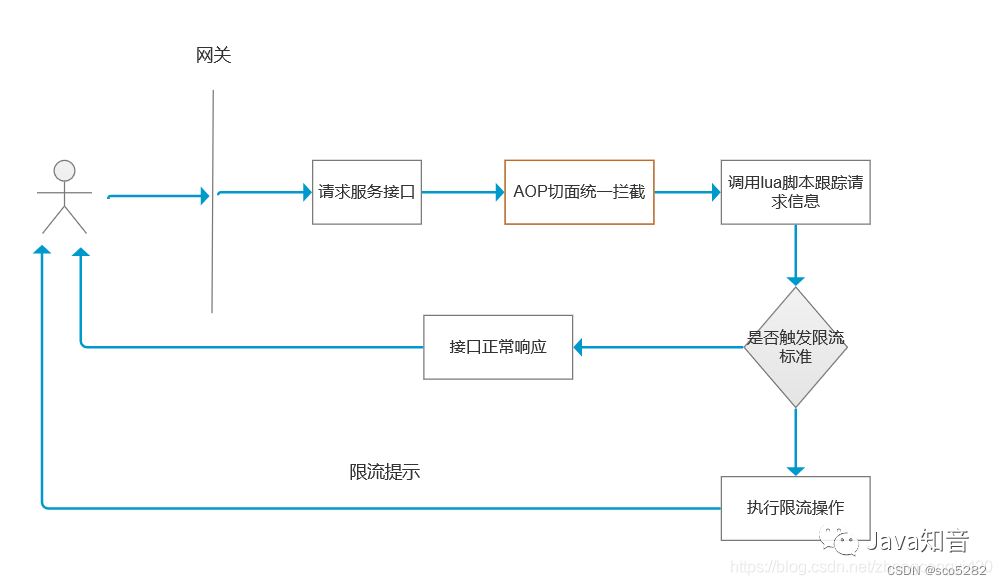
结合上面的流程图,这里梳理出一个整体的实现思路:
- 编写 lua 脚本,指定入参的限流规则,比如对特定的接口限流时,可以根据某个或几个参数进行判定,调用该接口的请求,在一定的时间窗口内监控请求次数;
- 既然是限流,最好能够通用,可将限流规则应用到任何接口上,那么最合适的方式就是通过自定义注解形式切入;
- 提供一个配置类,被 spring 的容器管理,redisTemplate 中提供了 DefaultRedisScript这个 bean;
- 提供一个能动态解析接口参数的类,根据接口参数进行规则匹配后触发限流;
1、引入 redis 依赖
<dependency>
<groupId>org.springframework.boot</groupId>
<artifactId>spring-boot-starter-data-redis</artifactId>
</dependency>
2、自定义注解
@Documented
@Target(value = ElementType.METHOD)
@Retention(value = RetentionPolicy.RUNTIME)
public @interface RedisLimitAnnotation {
/**
* key
*/
String key() default "";
/**
* Key的前缀
*/
String prefix() default "";
/**
* 限流时间内限流次数
*/
int count();
/**
* 限流时间,单位秒
*/
int period();
/**
* 限流的类型(接口、请求ip、用户自定义key)
*/
LimitTypeEnum limitType() default LimitTypeEnum.INTERFACE;
}
LimitTypeEnum:枚举类,定义限流类型
@Getter
public enum LimitTypeEnum {
// 默认限流策略,针对某一个接口进行限流
INTERFACE
,
// 根据IP地址进行限流
IP
,
// 自定义的Key
CUSTOMER
;
}
3、自定义 redis 配置类:解决 redis 序列化与读取 lua 脚本
@Configuration
public class RedisConfiguration {
@Bean
public DefaultRedisScript<Number> redisLuaScript() {
DefaultRedisScript<Number> redisScript = new DefaultRedisScript<>();
redisScript.setScriptSource(new ResourceScriptSource(new ClassPathResource("lua\\limit.lua")));
// 设置lua脚本返回值类型 需要同lua脚本中返回值一致
redisScript.setResultType(Number.class);
return redisScript;
}
@Bean("redisTemplate")
public RedisTemplate<String, Object> redisTemplate(RedisConnectionFactory redisConnectionFactory) {
RedisTemplate<String, Object> redisTemplate = new RedisTemplate<>();
redisTemplate.setConnectionFactory(redisConnectionFactory);
Jackson2JsonRedisSerializer jackson2JsonRedisSerializer = new Jackson2JsonRedisSerializer(Object.class);
//设置value的序列化方式为JSOn
redisTemplate.setValueSerializer(jackson2JsonRedisSerializer);
//设置key的序列化方式为String
redisTemplate.setKeySerializer(new StringRedisSerializer());
redisTemplate.setHashKeySerializer(new StringRedisSerializer());
redisTemplate.setHashValueSerializer(jackson2JsonRedisSerializer);
redisTemplate.afterPropertiesSet();
return redisTemplate;
}
}
4、自定义限流 AOP 类:进行限流操作
@Aspect
@Component
public class RedisLimitAspect {
private static final Logger logger = LoggerFactory.getLogger(RedisLimitAspect.class);
@Autowired
private RedisTemplate<String, Object> redisTemplate;
@Autowired
private DefaultRedisScript<Number> redisLuaScript;
@Pointcut(value = "@annotation(com.hcr.sbes.limit.redis.RedisLimitAnnotation)")
public void rateLimit() {
}
@Around("rateLimit()")
public Object interceptor(ProceedingJoinPoint joinPoint) throws Throwable {
MethodSignature signature = (MethodSignature) joinPoint.getSignature();
Method method = signature.getMethod();
RedisLimitAnnotation rateLimit = method.getAnnotation(RedisLimitAnnotation.class);
if (Objects.isNull(rateLimit)) {
return joinPoint.proceed();
}
String key = getKeyByLimitType(rateLimit, signature);
//调用lua脚本,获取返回结果,这里即为请求的次数
Number number = redisTemplate.execute(redisLuaScript, Collections.singletonList(key), rateLimit.count(), rateLimit.period());
if (number != null && number.intValue() != 0 && number.intValue() <= rateLimit.count()) {
logger.info("限流时间段内访问了第:{} 次", number);
return joinPoint.proceed();
}
throw new RuntimeException("访问频率过快,被限流了");
}
/**
* redis key 有三种
* 1. 自定义Key: prefix + ":" + key (key 不能为空)
* 2. 接口key:prefix + ":" + 接口全类名
* 3. Ip key:prefix + ":" + ip + "-" + 接口全类名
*
* @author zzc
* @date 2023/7/20 16:33
* @param redisLimitAnnotation
* @param signature
* @return java.lang.String
*/
private String getKeyByLimitType(RedisLimitAnnotation redisLimitAnnotation, MethodSignature signature) {
String key = "";
LimitTypeEnum limitTypeEnum = redisLimitAnnotation.limitType();
String prefix = redisLimitAnnotation.prefix();
if (StringUtils.isNotBlank(prefix)) {
key = prefix + ":";
}
if (LimitTypeEnum.CUSTOMER == limitTypeEnum) {
// 自定义
String tempKey = redisLimitAnnotation.key();
if (StringUtils.isBlank(tempKey)) {
throw new RuntimeException("自定义类型下 key 不能为空!");
}
return key + tempKey;
}
Method method = signature.getMethod();
Class<?> targetClass = method.getDeclaringClass();
String classFullName = targetClass.getName() + "-" + method.getName();
if (LimitTypeEnum.INTERFACE == limitTypeEnum) {
return key + classFullName;
}
// IP
HttpServletRequest request = ((ServletRequestAttributes) RequestContextHolder.getRequestAttributes()).getRequest();
String ipAddress = IpUtil.getIpAddr(request);
return key + ipAddress + "-" + classFullName;
}
}
IpUtil:获取 ip
public class IpUtil {
public static String getIpAddr(HttpServletRequest request) {
String ip = request.getHeader("x-forwarded-for");
if (ip == null || ip.length() == 0 || "unknown".equalsIgnoreCase(ip)) {
ip = request.getHeader("Proxy-Client-IP");
}
if (ip == null || ip.length() == 0 || "unknown".equalsIgnoreCase(ip)) {
ip = request.getHeader("WL-Proxy-Client-IP");
}
if (ip == null || ip.length() == 0 || "unknown".equalsIgnoreCase(ip)) {
ip = request.getHeader("HTTP_CLIENT_IP");
}
if (ip == null || ip.length() == 0 || "unknown".equalsIgnoreCase(ip)) {
ip = request.getHeader("HTTP_X_FORWARDED_FOR");
}
if (ip == null || ip.length() == 0 || "unknown".equalsIgnoreCase(ip)) {
ip = request.getRemoteAddr();
}
// 本机访问
if ("localhost".equalsIgnoreCase(ip) || "127.0.0.1".equalsIgnoreCase(ip) || "0:0:0:0:0:0:0:1".equalsIgnoreCase(ip)){
// 根据网卡取本机配置的IP
InetAddress inet;
try {
inet = InetAddress.getLocalHost();
ip = inet.getHostAddress();
} catch (UnknownHostException e) {
e.printStackTrace();
}
}
// 对于通过多个代理的情况,第一个IP为客户端真实IP,多个IP按照','分割
//"***.***.***.***".length() = 15
if (null != ip && ip.length() > 15) {
if (ip.indexOf(",") > 15) {
ip = ip.substring(0, ip.indexOf(","));
}
}
return ip;
}
}
该类要做的事情和上面的两种限流措施类似,不过在这里核心的限流是通过读取lua脚步,通过参数传递给lua脚步实现的
5、自定义 lua 脚本:保证redis中操作原子性
在工程的 resources/lua 目录下,添加如下的 lua 脚本
-- 定义变量:redis中key值、规定的时间段内访问次数、redis中过期时间、当前访问次数
local key = KEYS[1]
local limit = tonumber(ARGV[1])
local count = tonumber(ARGV[2])
local current = tonumber(redis.call('get', key) or "0")
if current + 1 > limit then
return 0
end
-- 没有超阈值,将当前访问数量+1,
current = redis.call("INCRBY", key, "1")
if tonumber(current) == 1 then
-- 设置过期时间
redis.call("expire", key, count)
end
return tonumber(current)
6、测试接口
@RestController
@RequestMapping("/limit")
public class LimitController {
@GetMapping("/limitByRedis")
@RedisLimitAnnotation(key = "limitByRedis", period = 1, count = 1, limitType = LimitTypeEnum.IP)
public String limitByRedis() {
return "limitByRedis";
}
}
JAVA自定义注解实现接口/ip限流
4. 基于网关 gateway 限流(分布式版)
gateway:使用的是 Redis 加 lua 脚本的方式实现的令牌桶
暂不作介绍
5. 自定义starter限流实现
上面通过案例介绍了几种常用的限流实现,可以看到这些限流的实现都是在具体的工程模块中嵌入的。
事实上,在真实的微服务开发中,一个项目可能包含了众多的微服务模块,为了减少重复造轮子,避免每个微服务模块中单独实现,可以考虑将限流的逻辑实现封装成一个 SDK,即作为一个 springboot 的 starter 的方式被其他微服务模块进行引用即可。
这也是目前很多生产实践中比较通用的做法,接下来看看具体的实现吧。
5.1 准备
创建一个空的springboot工程,工程目录结构如下图,目录说明:
- annotation:存放自定义的限流相关的注解;
- aspect:存放不同的限流实现,比如基于guava的aop,基于sentinel的aop实现等;
- spring.factories:自定义待装配的aop实现类
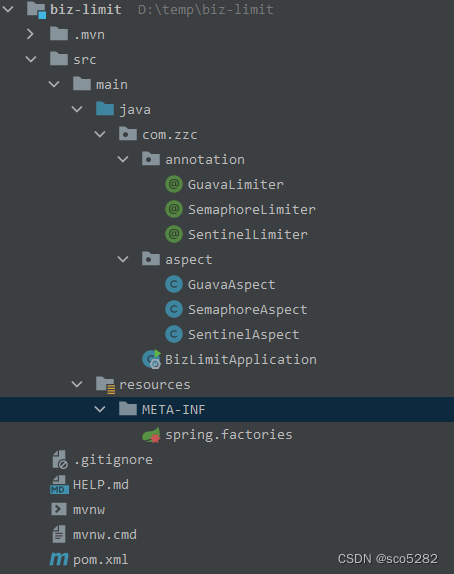
5.2 代码实战
5.2.1 导入基础的依赖
这里包括如下几个必须的依赖:
- spring-boot-starter;
- guava;
- spring-boot-autoconfigure;
- sentinel-core;
<dependencies>
<dependency>
<groupId>org.springframework.boot</groupId>
<artifactId>spring-boot-starter</artifactId>
</dependency>
<dependency>
<groupId>org.springframework.boot</groupId>
<artifactId>spring-boot-starter-web</artifactId>
</dependency>
<dependency>
<groupId>org.aspectj</groupId>
<artifactId>aspectjweaver</artifactId>
</dependency>
<dependency>
<groupId>com.google.guava</groupId>
<artifactId>guava</artifactId>
<version>31.1-jre</version>
</dependency>
<dependency>
<groupId>com.alibaba.csp</groupId>
<artifactId>sentinel-core</artifactId>
<version>1.8.0</version>
</dependency>
<dependency>
<groupId>org.projectlombok</groupId>
<artifactId>lombok</artifactId>
<optional>true</optional>
</dependency>
<dependency>
<groupId>com.alibaba</groupId>
<artifactId>fastjson</artifactId>
<version>1.2.78</version>
</dependency>
</dependencies>
<!--springboot打包-->
<!--<build>
<plugins>
<plugin>
<groupId>org.springframework.boot</groupId>
<artifactId>spring-boot-maven-plugin</artifactId>
</plugin>
</plugins>
</build>-->
<!--maven打包-->
<build>
<plugins>
<plugin>
<groupId>org.apache.maven.plugins</groupId>
<artifactId>maven-compiler-plugin</artifactId>
<version>3.8.1</version>
<configuration>
<source>1.8</source>
<target>1.8</target>
</configuration>
</plugin>
</plugins>
</build>
【注意】:这里需要替换成 maven 打包工具。
5.2.2 自定义注解
目前该SDK支持三种限流方式,即后续其他微服务工程中可以通过添加这3种注解即可实现限流,分别是基于guava的令牌桶,基于sentinel的限流,基于java自带的Semaphore限流,三个自定义注解类如下:
令牌桶:
@Target(value = ElementType.METHOD)
@Retention(value = RetentionPolicy.RUNTIME)
public @interface GuavaLimiter {
int value() default 50;
}
Semaphore:
@Target(value = ElementType.METHOD)
@Retention(value = RetentionPolicy.RUNTIME)
public @interface SemaphoreLimiter {
int value() default 50;
}
sentinel:
@Target(value = ElementType.METHOD)
@Retention(value = RetentionPolicy.RUNTIME)
public @interface SentinelLimiter {
String resourceName();
int limitCount() default 50;
}
5.2.3 限流实现 AOP 类
具体的限流在 AOP 中进行实现,思路和上一章节类似,即通过环绕通知的方式,先解析那些添加了限流注解的方法,然后解析里面的参数,进行限流的业务实现
基于 guava 的 aop 实现:
@Slf4j
@Aspect
@Component
public class GuavaAspect {
private final Map<String, RateLimiter> rateLimiters = new ConcurrentHashMap<>();
@Pointcut("@annotation(com.zzc.annotation.GuavaLimiter)")
public void aspect() {
}
@Around(value = "aspect()")
public Object around(ProceedingJoinPoint point) throws Throwable {
log.debug("准备限流");
Object target = point.getTarget();
String targetName = target.getClass().getName();
String methodName = point.getSignature().getName();
Object[] arguments = point.getArgs();
Class<?> targetClass = Class.forName(targetName);
Class<?>[] argTypes = ReflectUtils.getClasses(arguments);
Method method = targetClass.getDeclaredMethod(methodName, argTypes);
// 获取目标method上的限流注解@Limiter
GuavaLimiter limiter = method.getAnnotation(GuavaLimiter.class);
RateLimiter rateLimiter = null;
Object result = null;
if (Objects.isNull(limiter)) {
return point.proceed();
}
// 以 class + method + parameters为key,避免重载、重写带来的混乱
String key = targetName + "." + methodName + Arrays.toString(argTypes);
rateLimiter = rateLimiters.get(key);
if (null == rateLimiter) {
// 获取限定的流量
// 为了防止并发
rateLimiters.putIfAbsent(key, RateLimiter.create(limiter.value()));
rateLimiter = rateLimiters.get(key);
}
boolean b = rateLimiter.tryAcquire();
if(b) {
log.debug("得到令牌,准备执行业务");
return point.proceed();
} else {
HttpServletResponse resp = ((ServletRequestAttributes) RequestContextHolder.getRequestAttributes()).getResponse();
JSONObject jsonObject = new JSONObject();
jsonObject.put("success",false);
jsonObject.put("msg","限流中");
try {
output(resp, jsonObject.toJSONString());
}catch (Exception e){
e.printStackTrace();
}
}
log.debug("退出限流");
return result;
}
public void output(HttpServletResponse response, String msg) throws IOException {
response.setContentType("application/json;charset=UTF-8");
ServletOutputStream outputStream = null;
try {
outputStream = response.getOutputStream();
outputStream.write(msg.getBytes("UTF-8"));
} catch (IOException e) {
e.printStackTrace();
} finally {
outputStream.flush();
outputStream.close();
}
}
}
基于 Semaphore 的 aop 实现:
@Slf4j
@Aspect
@Component
public class SemaphoreAspect {
private final Map<String, Semaphore> semaphores = new ConcurrentHashMap<>();
@Pointcut("@annotation(com.zzc.annotation.SemaphoreLimiter)")
public void aspect() {
}
@Around(value = "aspect()")
public Object around(ProceedingJoinPoint point) throws Throwable {
log.debug("进入限流aop");
Object target = point.getTarget();
String targetName = target.getClass().getName();
String methodName = point.getSignature().getName();
Object[] arguments = point.getArgs();
Class<?> targetClass = Class.forName(targetName);
Class<?>[] argTypes = ReflectUtils.getClasses(arguments);
Method method = targetClass.getDeclaredMethod(methodName, argTypes);
// 获取目标method上的限流注解@Limiter
SemaphoreLimiter limiter = method.getAnnotation(SemaphoreLimiter.class);
Object result = null;
if (Objects.isNull(limiter)) {
return point.proceed();
}
// 以 class + method + parameters为key,避免重载、重写带来的混乱
String key = targetName + "." + methodName + Arrays.toString(argTypes);
// 获取限定的流量
Semaphore semaphore = semaphores.get(key);
if (null == semaphore) {
semaphores.putIfAbsent(key, new Semaphore(limiter.value()));
semaphore = semaphores.get(key);
}
try {
semaphore.acquire();
result = point.proceed();
} finally {
if (null != semaphore) {
semaphore.release();
}
}
log.debug("退出限流");
return result;
}
}
基于 sentinel 的 aop 实现:
@Aspect
@Component
public class SentinelAspect {
@Pointcut(value = "@annotation(com.zzc.annotation.SentinelLimiter)")
public void rateLimit() {
}
@Around("rateLimit()")
public Object around(ProceedingJoinPoint joinPoint) {
//1、获取当前的调用方法
Method currentMethod = getCurrentMethod(joinPoint);
if (Objects.isNull(currentMethod)) {
return null;
}
//2、从方法注解定义上获取限流的类型
String resourceName = currentMethod.getAnnotation(SentinelLimiter.class).resourceName();
if(StringUtils.isEmpty(resourceName)){
throw new RuntimeException("资源名称为空");
}
int limitCount = currentMethod.getAnnotation(SentinelLimiter.class).limitCount();
initFlowRule(resourceName,limitCount);
Entry entry = null;
Object result = null;
try {
entry = SphU.entry(resourceName);
try {
result = joinPoint.proceed();
} catch (Throwable throwable) {
throwable.printStackTrace();
}
} catch (BlockException ex) {
// 资源访问阻止,被限流或被降级
// 在此处进行相应的处理操作
System.out.println("blocked");
return "被限流了";
} catch (Exception e) {
Tracer.traceEntry(e, entry);
} finally {
if (entry != null) {
entry.exit();
}
}
return result;
}
private static void initFlowRule(String resourceName,int limitCount) {
List<FlowRule> rules = new ArrayList<>();
FlowRule rule = new FlowRule();
//设置受保护的资源
rule.setResource(resourceName);
//设置流控规则 QPS
rule.setGrade(RuleConstant.FLOW_GRADE_QPS);
//设置受保护的资源阈值
rule.setCount(limitCount);
rules.add(rule);
//加载配置好的规则
FlowRuleManager.loadRules(rules);
}
private Method getCurrentMethod(JoinPoint joinPoint) {
Method[] methods = joinPoint.getTarget().getClass().getMethods();
Method target = null;
for (Method method : methods) {
if (method.getName().equals(joinPoint.getSignature().getName())) {
target = method;
break;
}
}
return target;
}
}
5.2.4 配置自动装配 AOP 实现
在resources目录下创建上述的spring.factories文件,内容如下,通过这种方式配置后,其他应用模块引入了当前的SDK的jar之后,就可以实现开箱即用了;
org.springframework.boot.autoconfigure.EnableAutoConfiguration=\
com.zzc.aspect.GuavaAspect,\
com.zzc.aspect.SemaphoreAspect,\
com.zzc.aspect.SentinelAspect
5.2.5 将工程打成 jar 进行安装
mvn-install 命令
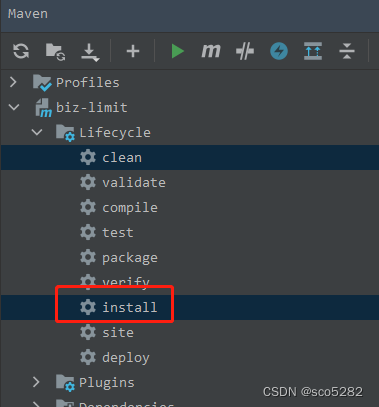
5.2.6 在其他的工程中引入上述 SDK
<dependency>
<groupId>com.zzc</groupId>
<artifactId>biz-limit</artifactId>
<version>0.0.1-SNAPSHOT</version>
</dependency>
5.2.7 编写测试接口
@RestController
@RequestMapping("/limit")
public class LimitController {
@GuavaLimiter(1)
@GetMapping("/guavaLimiter")
public String guavaLimiter(){
return "guavaLimiter";
}
}
上述通过starter的方式实现了一种更优雅的限流集成方式,也是生产中比较推荐的一种方式,不过当前的案例还比较粗糙,需要使用的同学还需根据自己的情况完善里面的逻辑,进一步的封装以期得到更好的效果。
